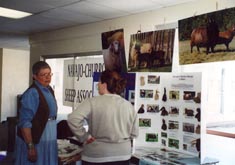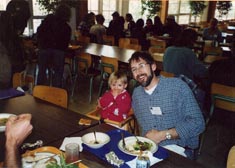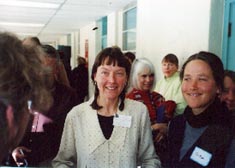 |
|
|
Volume VI |
March 2001 |
Number III |
|
|
Collaborative Stewardship At Work: a Two-Day "Unconference" April 27-28, (Fri-Sat), 2001 at the Kachina Inn, Taos, New MexicoANNOUNCEMENTSLETTERSLa Jicarita Wastewater Study Committee Commits to Developing Master Plan for the Watershed By Kay MatthewsEditorial: Organic Expo Demonstrates Commitment to Maintaining our Agricultural Lands By Kay Matthews |
Editorial: Land Grant Reparation: The Government Can't Just Buy It's Way Out of this One By Mark Schiller Mechanical Thinning Versus Fire: Which is Better for Forest Health? By Max Córdova Jr., Montaña de Truchas Youth Team |
Collaborative Stewardship At Work: a Two-Day “Unconference” April 27-28, (Fri-Sat), 2001 at the Kachina Inn, Taos, New MexicoThis free conference will highlight the innovative, collaborative, and community-driven work being done to restore environmental and economic vitality on public and private land in northern New Mexico. Although the mountains and valleys of northern New Mexico have been home to indigenous peoples for many centuries, traditional, self-sustaining work, including subsistence farming, timbering, ranching, and other economic activities are now threatened by a host of diverse pressures. Compounding these threats is a long and frequently contentious relationship between local residents and federal land-management agencies, epitomized by the long-running dispute over the fate of historic land grants. In the mid-1990s, after years of conflict, the residents of Truchas, Peñasco, and other neighboring mountain villages decided to try a new tack and opened a dialogue with the staff of the Camino Real District of the United States Forest Service in an attempt to find a better way of managing, and restoring the land they all shared. They chose cooperation over confrontation and found a partner in the Forest Service. Together, they called their work "Collaborative Stewardship." In 1998, this innovative partnership earned national recognition when it was awarded the Innovations in Government Award from the Kennedy School of Government at Harvard University. This conference will share our story, and encourage others to build on our successes and learn from our failures. It is organized around three topics vital to the future of the communities of the region -"WATER/AGRICULTURE (Soil), COMMUNITY FORESTRY (Trees), AND GRAZING (Grass) " - which will be discussed in half-day sessions. The focus of each session will be the innovative practices being used to keep the acequia system viable, keep people in agriculture, and maintain cultural traditions. These practices also include the formation of regional acequia associations to maintain community control of water; the creation of niche markets for organic and locally produced fruit, vegetables and meat; contract stewardship blocks to produce sustainably harvested firewood and building materials such as vigas, latillas, and fence posts; and grazing allotment restoration, herding, and grassbanks for sustainable cattle management. Most importantly, the conference's experts will be the residents themselves: local farmers and ranchers, woodlot operators, and Forest Service personnel. Each is united by a desire to challenge "business-as-usual" in the way our land is administered by engaging in a collaborative approach to good stewardship. It is our hope that this conference will lead the way for future collaborative relationships between local communities, federal agencies, nonprofit organizations, environmental groups, and other people who believe that the future lies in shaking hands and pursuing common goals for the common good. Speakers include: Lynda Prim, The Farm Connection Paula Garcia, New Mexico Acequia Association Brett Olsen, lawyer Henry Lopez, USFS Max Córdova, La Montaña de Truchas Ike De Vargas, La Companía Ocho Kirt Winchester, USFS Jan-Willem Jansens, Common Ground Louis Hena, Picuris Pueblo Environment Department Abe Franklin, NM Environment Department George Maestas, Estevan Lopez, Santa Barbara Grazing Association Steve Miranda, USFS Virgil Trujillo, Ghost Ranch Joe Torres, Valle Vidal Grazing Association Courtney White, Quivira Coalition Will Barnes, The Conservation Fund Matt Mitchell, organic beef rancher For more information call Courtney at 820-2544
ANNOUNCEMENTS• Embudo Valley Community Supported Agriculture Accepting New Members for 2001. Community Supported Agriculture (CSA) is an alliance between farmers and community members to support local, ecologically sustainable agriculture. The Embudo Valley CSA is a co-operative effort among three Dixon growers. You can become a member of our CSA by purchasing a share of our farm's harvest. In return, you will receive a weekly bag of vegetables for 6 months, from May to November. A full share provides enough vegetables for a week for a family or group household of two adults who eat a lot of vegetables or four people who eat fewer vegetables. A full share costs $15.38 per week. Half shares for individuals or small families are available for only $8.46 a week.When you buy food from a local grower, you help to preserve the things we value most: healthy and productive farmlands, active acequias, a community with a network of social and economic relationships among friends and neighbors, and the important role food plays in sustaining family and community life. If you would like to become a member of our CSA, or request more information, please call Felicity Fonseca in Dixon at 505-579-4085, or write to us at P.O. Box 548, Dixon, NM 87527 or ffonseca@cybermesa.com. • The Online Civilian Conservation Corps Museum is seeking the stories about the CCCs, CCC Enrollees, Staff, or Technical Advisors for publication to this online historical resource. If you would like to participate please send your stories, with name company number and location if known, to Justin CCC Museum, PO Box 5, Woodbury NJ 08096 or email to JFJmuseum@aol.com. LETTERS"Thank You" From Sandra Sue R. Richardson Although I didn't win the Peñasco School Board Election held February 6, I would like to thank you for your support and input during my four years of service on the Peñasco School Board. I hope I was helpful in addressing your concerns and issues regarding the Peñasco School Board system. I feel that the students in our district are well served by the excellent staff who have the expertise and education of our children at heart. I would like to wish the very best to the Peñasco School Board members, administrative staff, teachers, students, and of course, the good people of the Peñasco Valley communities. Thank you
La Jicarita Wastewater Study Committee Commits to Developing Master Plan for the WatershedBy Kay MatthewsFor more than five years representatives of the domestic water associations in La Jicarita watershed have been meeting to discuss their concerns about contamination of the Rio Pueblo and its tributaries, and to look at possible solutions. After the Pueblo of Picuris adopted Environmental Protection Agency Clean Water Standards in 1995, it joined together with these associations to create La Jicarita Wastewater Study Committee. Over the course of the next few years the committee began to raise funds for a Wastewater Master Plan, and in 2000 contracted with WaterWorks, a non-profit Santa Fe engineering firm, to act as project manager. The committee to date has raised $95,000 to underwrite the costs of a wastewater assessment study: $45,000 from the 2000 state legislature; $25,000 from McCune Charitable Foundation; and $25,000 from the Healy Foundation.The projected cost of a regional water plan, which would include an assessment of regional needs for the next 20 years by evaluating population growth, a hydrogeological study, surface water assessments, and designs for alternative wastewater systems, is $380,000. The committee has submitted a funding request to the 2001 legislature for the cost of this master plan. WaterWorks will focus its initial work in the area of the watershed immediately surrounding the Pueblo: Vadito, Peñasco, Rio Lucio, and Chamisal. The company has committed to donating the extra $60,000 it estimates the study will cost, and will be an active partner in helping raise the additional funds necessary to extend the study to the upper watershed, where collaboration with public lands agencies will be essential. The first priority of the study will be to determine if wastewater is indeed the primary source of pollution in the watershed. According to WaterWorks engineer Sasha Earle, "We are prepared to start from ground zero, but all the information we can gather from other agency studies will be incorporated into our study." Already, information collected by the Picuris Pueblo Environment Department from the upper watershed to the Embudo confluence indicates a decline in water quality. Several wells in the study area have revealed unacceptable levels of nitrates (60 milliliters per liter as opposed to EPA standards of 10 milliliters per liter). This first phase of the study is estimated to take approximately 18 months. Once the data has been collected and analyzed, the company will provide a Preliminary Engineering Report (PER), which will include an assessment of possible treatment alternatives, focusing on low-tech, passive systems that are cost effective and can be operated and maintained by community people. These include recirculating sand filters, wetlands, pond systems, and mechanical systems. All of these options can be blended into an overall system that best fits the needs of the area. WaterWorks also offers community assisted construction: equipment teams can be brought into communities to help them build the system with sweat equity, which keeps the costs low and trains community people in management operation. The PER will also identify a priority treatment project and costs, so that the committee can go to the state legislature, government agencies, and foundations for grants or low interest loans. WaterWorks will also be responsible for organizing community meetings for public input and dissemination of information. At the first meeting on February 17, Ronald Rodriguez, chairman of the study committee, emphasized that this effort is a community partnership, one of the first times the Pueblo and local communities have come together to address an issue that affects the entire watershed. "All we have to do is look at how fast our communities are growing to validate the need for this study," Rodriguez said at the meeting. Newly elected Taos County Commissioner Gabe Romero attended the meeting and told the group, "I commit myself to this board and the work you are doing." Based on his own experience as a board member of the El Valle Water and Sanitation District in Ranchos de Taos, he recommended to the committee that it start the process of officially forming a district or authority so that when the initial wastewater study is completed there will be an entity in place to acquire funds (Picuris Pueblo is currently acting as the fiscal agent for the project). All the committee and project members who spoke at the community meeting - Ronald Rodriguez, Sasha Earle, Estevan Lopez, and Eagle Rael - emphasized that impending growth is the biggest threat the watershed faces, and that the communities need to get started now to get ahead of the game once water resources are impacted by more infill and development. Earle pointed out that while his non-profit company is a partner in this project that will work with the communities on best management decisions, if the area doesn't address the issue now it could ultimately face federal or state intervention, where the costs and restrictions of remediation would be much higher and the communities would have less input and control. Editorial: Organic Expo Demonstrates Commitment to Maintaining our Agricultural LandsBy Kay MatthewsA wealth of information, ideas, and food kept all the farmers and ranchers busy and filled up at the recent New Mexico Organic Farming and Gardening Expo at the Glorieta Baptist Conference Center. The annual event, organized by The Farm Connection and the New Mexico Organic Commodities Commission, brought together all kinds of folks who grow organic vegetables and flowers, raise organic turkeys or cows, process herbs into oils, spin wool from churro sheep, and engage in private or public efforts to maintain the agricultural lands that support all of these activities. While it was hard to choose from the many workshops offered throughout the day - cooperative marketing, organic beef production, farm labor, the New Ranch - I chose to attend one that discussed conservation easements and policy mandates that work to keep land in agricultural production. It was obvious from the discussion, led by Jim McCord of the Rio Grande Agricultural Land Trust and Julie Gallegos of the Rio Grande Headwaters Land Trust, that we must slow down the rate at which agricultural lands are being lost in New Mexico: 1.1 million acres between 1992 and 1997. In the middle Rio Grande area where McCord owns a farm near Socorro, and southern Colorado, where Gallegos ranches, land trusts provide protection for relatively large, or expensive, lands with conservation easements, which maintain extensive corridors of open land and support biodiversity. These easements, administered by the trusts, also provide income tax benefits, estate tax benefits, and allow for a certain amount of flexibility with regard to diverse management of the land, i.e., setting aside a certain percentage for the landowner's family to build houses. But here in northern New Mexico, where farmland has already been divided up among families over many generations, and where communities are hemmed in on all sides by public lands, land trusts are not as appropriate. What is essential to protect our lands is public policy initiatives that prevent irrigated lands from being developed. This is what the Rio Arriba County's Agricultural Protection and Enhancement Ordinance is designed to do: manage subdivision and residential development by requiring cluster housing, which preserves 70% of the property in undeveloped agriculture. Well and wastewater criteria in the ordinance also protects ground and surface water from contamination. In the course of the discussion, McCord also raised the issue of water management, specifically last summer's release of San Juan/Chama surface water to maintain silvery minnow habitat south of Socorro: "Invoking the Endangered Species Act is adversely affecting our attempts to save farmlands," McCord said. "It creates contempt for the Act and the environmentalists who use it." McCord also pointed out that many people in the scientific community with whom he works think the release was a wasted effort that didn't protect the minnow and seriously threatened future water supplies. If the ultimate effect of enforcing the ESA is to further marginalize farmers, their lands will quickly be sold off for development, and the open space habitat they preserve will be forever lost. Unfortunately, some folks in the environmental movement like to argue that the cost of maintaining farm and ranch lands is too high or that subdivisions are not necessarily bad. Anti-grazing advocates argue that ranching can't stop sprawl and that we have to prevent both "condos and cows" with land use restrictions. Given current economic trends across the west this argument is not only naive, it fails to analyze the difference between condos and cows as a class issue. Dan Flores, a professor of history at the University of Montana, is guilty of this same failure. While he has written previously about inhabited wilderness and the biocentric bias of the environmental community, in a High Country News feature in 1999 he argues that automatically judging Montana "ranchettes" as "bad" buys into the argument that all human touch is insidious and that we all belong in cities. He, like the anti-grazers, fails to see that "ranchettes" versus farms and ranches is another issue of class: only those humans with enough disposable income or fax machines can inhabit the rural west. Even more disturbing is another essay in High Country News by Hal Rothman, who is best known for his book Devil's Bargain about the dangers of relying on tourism as an economic development strategy. Called "Do we really need the rural West?" he essentially says that rural people are a drain on the country's economy, that we're using up all the water, and that we need to get out of the way of the urbanites who need that water to drink and water their golf courses and need the land to camp, ski, hunt, and ride ATVs. At first I thought, this essay must be tongue in cheek, but the editor of the newspaper, Ed Marston, didn't think so, because he responded to Rothman's question: Yes, we need the rural West to take care of the land in a sustainable fashion so there are healthy watersheds producing that urban water, providing healthy, regionally grown produce and meat, and preventing our forests from burning down and taking whole towns with them. The folks at the Organic Expo obviously agreed with Marston, and their work is testimony to the dedication and creativity of those who live on the land.
|
|
Home | Current Issue | Subscribe | About Us | Environmental Justice | Links | Archive | Index
Copyright 1996-2000 La Jicarita Box 6 El Valle Route, Chamisal, New Mexico 87521.






